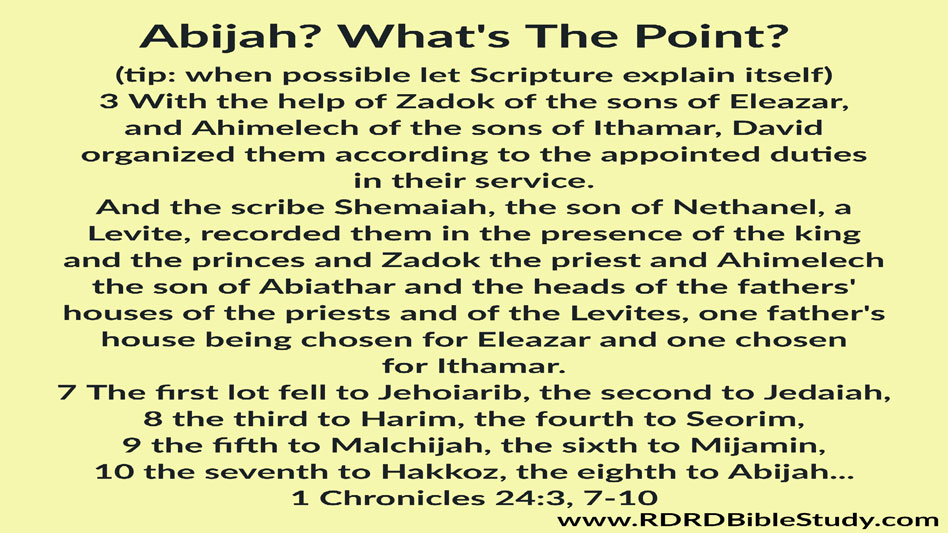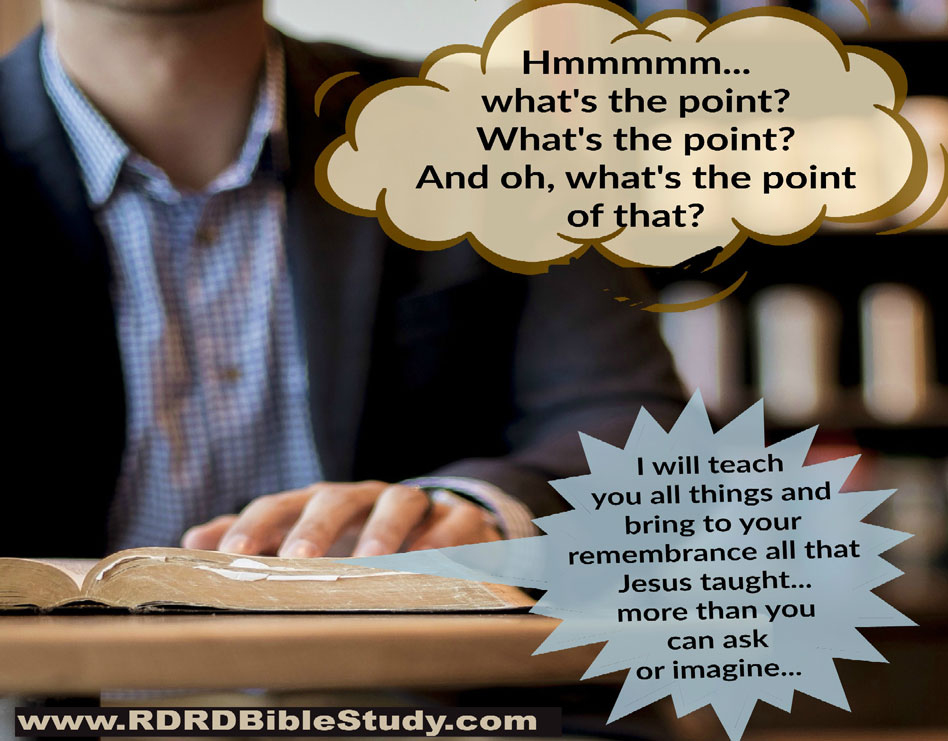What’s The Point? A Bible Study Technique
A Bible study technique for really delving into a passage is to ask “What’s the Point?” when reading the text. Aside from a book’s genre, this is the most important literary question to ask—of every sentence and every paragraph. “What’s the Point?” can also be asked of words and phrases—there is no limit. Ask this question multiple times throughout the passage being studied, regardless of its size.
Asking “What’s the point?” of every sentence and paragraph and deliberating the answer will reveal things that a cursory reading will not necessarily disclose.
For instance (and this is not an exhaustive list and some things depend on genre) the following will emerge:
- The outline of a passage
- How the sentences and paragraphs fit together
- The poetic form
- Tracing an author’s argument
Some “What’s The Point?” questions may have a historical answer so may require further historical reading. Some questions may have a theological answer so may need a fine-tuned systematic theological definition. Some may refer back to the OT and will need study of the OT passage, etc. Still, there will be “What’s The Point?” questions that can be answered based on the text.
Personally, I like to fill in any blanks as I go. But it is equally valid to answer as many questions as possible, do research, then come back and fill in the blanks. Then, of course, work back through the passage asking “what’s the point?”.
“What’s The Point?” Example
Let’s use Luke 1:1-9 as an example study passage. The question “What’s The Point?” will be asked as the passage is read.
Luke 1:1-4
(1) Inasmuch as many have undertaken to compile a narrative of the things that have been accomplished among us, What’s the point?
(2) just as those who from the beginning were eyewitnesses and ministers of the word What’s the point? have delivered them to us, What’s the point?
(3) it seemed good to me also, having followed all things closely for some time past, What’s the point? to write an orderly account for you, most excellent Theophilus, What’s the point?
(4) that you may have certainty concerning the things you have been taught. What’s the point? (Luke 1:1-4)
After answering these questions, ask
What’s the point of 1:1-4?
Luke 1:5-7
(5) In the days of Herod, king of Judea, What’s the point? there was a priest named Zechariah, of the division of Abijah. What’s the point? And he had a wife from the daughters of Aaron What’s the point?, and her name was Elizabeth. What’s the point?
(6) And they were both righteous before God, walking blamelessly in all the commandments and statutes of the Lord. What’s the point?
(7) But they had no child, because Elizabeth was barren, What’s the point? and both were advanced in years. What’s the point?
Ask
What’s the point of 1:5-7?
Luke 1:8-9
(8) Now while he was serving as priest before God when his division was on duty, What’s the point?
(9) according to the custom of the priesthood, What’s the point? he was chosen by lot What’s the point? to enter the temple of the Lord and burn incense. What’s the point?
Ask
What’s the point of Luke 1:8-9?
End of Luke 1:1-9
And since v.9 is the end of the passage, ask:
What’s the point of 1:1-4 in relation to 1:5-7?
What’s the point of 1:5-7 in relation to 1:8-9?
What’s the point of 1:1-9?
What’s the point of Luke 1?
What’s the point of Luke?
What’s the point of the NT?
Even in this short example, “What’s the point” is asked multiple times and could be asked even more. This may seem an overkill but give it a try. What do you have to lose?
Some of the answers may be short, while others may be lengthy.
When you answer, answer in your own words. You will be amazed at how much insight and understanding is gained through this short exercise.
Why Does “What’s The Point?” Work?
1. Slows Down The Reader Which Provides Time To Think
First of all, this technique works because it slows down the reader so that “What is the point of this sentence?” can really be considered. Why mention eyewitnesses? And, especially as the passage is worked through—what is the point of v. 7? And what is the point of Luke 1:5-7 and what does Luke 1:5-7 have to do with Luke 1:1-4? etc.
By slowing down and really thinking about the literary relationships—well, let me put it this way: If you do the “What’s the point?” questions with Luke 1:1-9, you will know more about this passage than perhaps any other in the Bible. And all of this without the help of a commentary. (Commentaries are extremely helpful, but save them for the last task when studying a passage.)
2. Helps The Reader Trace An Author’s Train Of Thought
Second, it helps the reader to trace an author’s train of thought.
“Why did Luke insert this sentence about Herod…?”
“Why does Luke point out that Zechariah was of the division of Abijah?”
“Why did Luke include Elizabeth’s ancestry?”
“Why does Luke include that Zechariah was chosen by lot?”
(Hint: That Zechariah was chosen by lot is an important note about God’s sovereignty. This is a clue that the sovereignty of God is an important theme in Luke’s Gospel.)
Tracing the author’s train of thought, or the progression of a narrative, etc., is extremely helpful in understanding exactly what the author is trying to get across to his audience. Keep in mind, the Bible is theological in nature, therefore the author is trying to communicate something about God. In the Gospels, the author is especially teaching about Jesus Christ the Son of God.
3. Highlights Multiple Points Within The Text
Each “what’s the point” may have one or several answers.
Take notes.
Reword them, if needed.
Scratch stuff out.
Rewrite something if you scratch it out and decide later to keep it.
Oh, and make a note why you did this.
Don’t try to be perfect.
Write what you think.
No one else will see your notes, unless you share them. You are working with the Holy Spirit to understand Scripture. This task is God-honoring. Trust me, He is faithful, and will show you things that will blow your mind.
Deep Diving into the Author’s Train of Thought
Understanding what the author is trying to get across to his audience was touched on briefly above. But let me reiterate. As the Biblical author communicates the Word of God, he writes in a train of thought, or flow-of-thought, where one thought leads to the next, and that one to the next, etc. Statement A prepares for statement B, B for C, etc.
A flow-of-thought is a sequence of related ideas that the author has organized to communicate something. Therefore, each sentence must be understood in light of the other ideas conveyed within the context.
A text without a context is a pretext to a proof text. As in any literary work, in order to understand what the author is trying to communicate, the overall context must always be taken into consideration. This is really just common sense, the normal way people communicate.
Don’t throw out common sense when studying the Bible.
What’s the point?
Until Next Time:
The grace of the Lord Jesus Christ and the love of God and the fellowship of the Holy Spirit be with you all. 2 Corinthians 13:14
Fun What’s The Point Homework
Cut and paste the “What’s the point?” example above into a word processing document. Work through the passage and answer each What’s the Point?
Hint: Finding the point/purpose of the entire book of Luke is as easy as reading:
- the introduction to Luke in your Bible
- an online summary such as Bible Study Tools’ summary of Luke
- a chapter on Luke from an Intro to the New Testament textbook such as D. A. Carson and Douglas Moo’s NT introduction and/or Frank Thielman’s Theology of the NT










